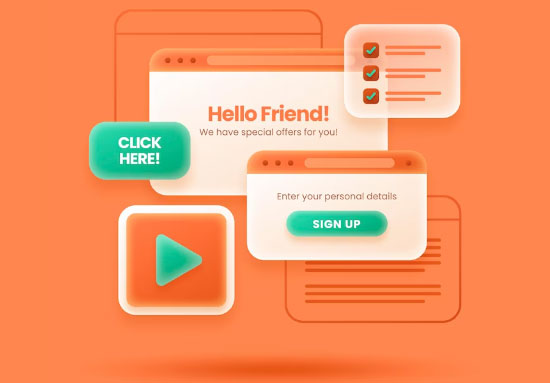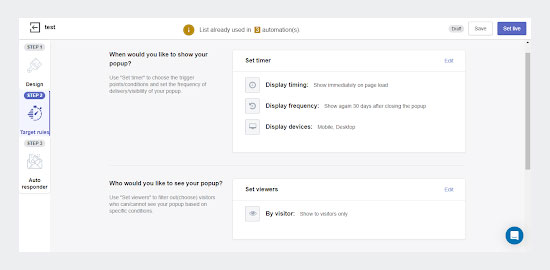Pop-ups are common in today’s digital landscape, appearing as small windows on top of a website’s content. They are often used to grab visitors’ attention and encourage them to take a specific action, such as subscribing to a newsletter, making a purchase, or providing feedback.
While some people find pop-ups annoying or intrusive, they remain a popular tool for website owners and marketers looking to increase engagement and conversions.
In this article, we’ll explore what pop-ups are, why they’re essential, and how you can create one for your webpage that engages visitors and boosts conversions.
What are Pop-ups?
Pop-ups are a type of web element that appears on top of the main content of a webpage. They are designed to grab visitors’ attention and usually contain important information, promotional offers, or call-to-action.
What are the types of pop-ups?
Pop-ups are typically categorized based on their behavior, purpose, and the context in which they appear. Here are some common types of pop-ups:
Modal pop-ups: These are the most common type of pop-up and appear in the center of the screen, often with a semi-transparent overlay that darkens the rest of the page. It can prompt users to sign up for a newsletter, download a resource, or complete a purchase.
Overlay pop-ups: These are similar to modal pop-ups but appear on top of the main content without a darkened overlay. Overlay pop-ups are usually smaller and less intrusive than modal pop-ups and can be used to promote special offers, ask for feedback, or display important information.
Slide-in pop-ups: These pop-ups slide in from the side or bottom of the screen and can promote content or encourage users to take specific actions. Slide-in pop-ups are less intrusive and can be a good option for websites that want to balance user experience with marketing goals.
Pop-up surveys: These pop-ups are designed to collect user feedback through surveys or polls. They can gather insights into user preferences, behavior, or satisfaction levels.
Exit-intent pop-ups: These exit-intent pop-ups are triggered when a user is about to leave the page, either by clicking the back button or closing the tab. They can offer a last-minute discount, encourage users to complete a purchase or provide an incentive to stay on the site.
Welcome mat pop-ups: These pop-ups cover the entire screen and appear immediately after a user lands on the page. It can be used to promote a specific offer, collect email addresses, or guide users to specific content.
Timed pop-ups: These pop-ups can be set to appear after a specific amount of time, such as five seconds or 30 seconds, or they can be triggered by user behavior, such as scrolling down a page or hovering over a specific element. The goal of a timed pop-up is to catch the user’s attention while they are actively engaged with the website and encourage them to take a specific action.
The pros and cons of using pop-ups
Pop-ups engage with their website visitors and prompt them to take specific actions. However, there are both pros and cons to using pop-ups, which we will explore below.
Pros:
- Increased conversions: Pop-ups are cost-effective lead generation strategies that can effectively increase conversions, such as capturing email addresses, promoting products or services, or encouraging signups. This is because they are often eye-catching and capture the visitor’s attention.
- Enhanced user experience: Pop-ups can also provide an enhanced user experience by providing additional information, guidance, or assistance to visitors, especially if they are well-designed and relevant to the content on the page.
- Targeted messaging: Pop-ups can target specific user segments, such as those who have visited a specific page or added items to their cart. This allows businesses to tailor their messaging to the individual user, increasing the likelihood of a conversion.
Cons:
- Intrusiveness: Pop-ups can be intrusive and disruptive to the user experience, particularly if they appear frequently or cover a large portion of the screen. This can lead to frustration or annoyance, ultimately driving users away from the website.
- Negative perception: Pop-ups can also have a negative perception among users, as they are often associated with spam or unwanted advertising. This can damage the business’s credibility and make visitors less likely to return to the site.
- Mobile compatibility: Pop-ups can be challenging to implement on mobile devices, where screen real estate is limited, and users are often more easily distracted. This can result in a poor user experience for mobile visitors.
However, using them in a targeted, relevant, and non-intrusive manner is vital to avoid damaging the user experience and driving visitors away from the website.
Benefits of using pop-ups
1. Promote special offers
Pop-ups can promote special offers, discounts, or free trials to visitors, incentivizing them to take a specific action. By highlighting these offers in an obvious way, pop-ups can increase the likelihood of visitors purchasing or signing up for a service. This can drive conversions and increase revenue for the business.
Pop-ups can also be targeted to specific user segments, such as first-time visitors or returning customers, to increase the effectiveness of the promotion.
2. Provide customer support
Pop-ups can provide customer support and assistance, such as offering a chat window or providing answers to frequently asked questions. By making it easier for visitors to get the help they need, businesses can improve the overall user experience and increase customer satisfaction.
Moreover, by resolving issues quickly and efficiently, businesses can improve their reputation and increase customer loyalty, leading to higher retention rates and increased revenue over time.
3. Grow social media following.
Using pop-ups to encourage visitors to follow a business on social media can help grow the brand’s online presence and increase customer engagement.
By providing a clear call-to-action and highlighting the benefits of following the brand on social media, such as exclusive offers or behind-the-scenes content, pop-ups can help to increase the number of followers and ultimately drive more traffic to the brand’s website.
4. Increase content visibility
Pop-ups can increase the visibility of content on a website by drawing the visitor’s attention to specific content, such as blog posts, videos, or promotions.
By using well-designed and targeted pop-ups, businesses can encourage visitors to engage with their content and spend more time on the website. This can ultimately increase engagement, build brand loyalty, and drive conversions.
5. Data capture
Pop-ups can capture user data, such as email addresses, demographic information, or customer preferences. This data can be used for future marketing campaigns or to understand the target audience better.
Using pop-ups to collect data, businesses can create more targeted and personalized marketing campaigns, leading to higher conversion rates and increased customer loyalty. Data capture is one of the key benefits of using pop-ups, allowing businesses to gain valuable insights into their audience and improve their marketing strategies.
6. Build brand awareness
Pop-ups can help you build brand awareness by promoting the brand’s unique value proposition or showcasing its products or services in a visually engaging way. With their ability to capture the visitor’s attention and display eye-catching visuals and messages, pop-ups can help increase brand recognition and loyalty among visitors.
By promoting the brand’s key features, benefits, and offerings, businesses can create a lasting impression in the minds of visitors and enhance their overall brand experience.
7 Best Practices for Creating Effective Pop-ups
Creating effective pop-ups is crucial for businesses to engage with their website visitors and drive conversions without negatively impacting the user experience. Here are seven best practices for creating effective pop-ups:
- Timing: Pop-ups should appear at the right time to avoid interrupting the user’s experience. Consider using time-delayed pop-ups or exit intent pop-ups, which occur when the visitor is about to leave the website.
- Relevance: Pop-ups should be relevant to visitors’ interests or needs based on browsing history, search queries, or demographics. Personalize the messaging and offer to make it more appealing.
- Clarity: Pop-ups should have clear and concise messaging, with a clear call-to-action (CTA) that encourages visitors to take the desired action. Use robust, action-oriented language such as “Get started now” or “Sign up today.”
- Design: Pop-ups should have a visually appealing design consistent with the website’s branding and color scheme. Use high-quality images, fonts, and graphics to make the pop-up stand out.
- Mobile-friendly: Pop-ups should be mobile-friendly and optimized for smaller screens, with easy-to-click CTAs and clear messaging without too much screen space.
- Testing: Test different pop-up designs, messaging, and timing to determine what works best for your audience. Use A/B testing to compare the performance of various versions of the pop-up.
- Exit options: Provide an easy and visible exit option for visitors who do not want to interact with the pop-up. This can include a clear “X” button or a “No thanks” option to avoid frustrating visitors.
How to create a Pop-up for your webpage with BayEngage
Creating a pop-up for your webpage with BayEngage is a simple process that can be completed in a few easy steps. Here’s how to do it:
Step 1: Log in to your BayEngage account.
Step 2: Click the “Signup forms” option on the left-hand sidebar.
Step 3: Click on the “Create new” button.
Step 4: Choose the type of pop-up you want to create. BayEngage offers several options, including “Newsletter Subscription,” “Discount Offer,” and “Exit Intent.”
Step 5: Customize the pop-up by adding your desired text, images, and design elements. You can also choose when and where the pop-up will appear on your website.
Step 6: Set the trigger for the pop-up to appear. This can be set to display immediately, after a certain amount of time, or when a user performs a specific action.
Step 7: Save your pop-up and Set live on your website.
That’s it! With these steps, you can easily create a pop-up for your webpage using BayEngage.
Conclusion
Pop-ups can be a powerful tool for businesses to engage with website visitors and drive conversions. By creating relevant, clear, and visually appealing pop-ups, businesses can capture visitors’ attention and encourage them to take the desired action.
However, it is essential to follow best practices, such as timing, relevance, design, and testing, to ensure that the pop-up does not negatively impact the user experience. With careful planning and execution, businesses can create effective pop-ups that enhance the visitor’s experience and contribute to the success of their online presence.






















